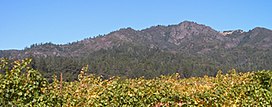Mount Hood (California)
| Mount Hood | |
|---|---|
 Mount Hood viewed from Sonoma Valley | |
| Highest point | |
| Elevation | 2,733 ft (833 m) NAVD 88[1] |
| Prominence | 1,970 ft (600 m)[2] |
| Coordinates | 38°27′36″N 122°33′12″W / 38.4599°N 122.55343°W[1] |
| Geography | |
| Location | Sonoma County, California, U.S. |
| Parent range | Mayacamas Mountains |
| Topo map | USGS Kenwood |
| Climbing | |
| Easiest route | Trail |
Mount Hood, also known as Hood Mountain is a mountain near the southeastern edge of
Area setting

Mount Hood is most easily accessed via State Route 12, which runs along the
Mount Hood is also visible from the floor of the
Geology and hydrology

The base of Mount Hood consists of soils of the Goulding-Toomes-Guenoc association, which are well-drained gently to very steep loams and clay-loams situated upon upland formations. The upper reaches consist of the Kidd-Forward-Cohasset association, which group ranges from well-drained to excessively drained moderate to very steep gravelly and stony loams.[5] Specific soil map patches on the upper slopes include Boomer loam on some 15 to 30 percent slopes; Goulding cobbly clay loam on 15 to 30 percent slopes; Henneke gravelly loam on some 5 to 30 percent slopes; Henneke gravelly loam on 30 to 75 percent slopes; and rock land on 15 to 75 percent slopes.
Considering the steepness of much of the terrain there is a remarkable lack of erosion, primarily because human access has been historically low, and vegetative cover has been kept intact. The headwaters of Santa Rosa Creek rise on the northern slopes of Mount Hood, whereas the central and eastern portions of the mountain contribute to the watershed of Sonoma Creek which rises in the Sugarloaf area. Hood Creek and Graywood Creek, draining portions of Mount Hood, are smaller tributaries that feed Sonoma Creek.[6] Precipitation amounts to approximately 30 inches (76.2 cm) per annum on Mount Hood.
Ecology
There are several distinct habitats[7] in the Mount Hood area including:
- Mixed oak woodland
- Chaparral
- Pygmy forest
- Riparian zone
In addition there is a specialized habitat on the upper western face consisting of extensive rock outcrops, which can be considered a variant of the chaparral habitat with small forest pockets.
The mixed oak woodland habitat dominates the lower elevations with
Chaparral areas are dominated by several varieties of
There are sizable pygmy forest areas on the west facing slopes and more level inner plateaus of Mount Hood. Here the predominant species are
The riparian zones tend to occur in deep heavily forested
Hiking
Trails leading to the summit of Mount Hood begin at three locations:
- Along Adobe Canyon Road within adjacent Sugarloaf Ridge State Park, on the southeast side of the mountain
- At the end of Pythian Road, on the west side
- At the end of Los Alamos Road, on the north side
Trails leading from the first two trailheads involve relatively direct climbs of about 2,000 vertical feet (610 m) to the
The Goodspeed/Nattkemper Trail, which climbs to the summit from the Adobe Canyon Road trailhead, offers the most direct access to the summit and to Gunsight Rock, from which distant views to the south and west are available. From the Los Alamos Road trailhead, the Hood Mountain Trail descends to and crosses
There is no
Name
The mountain is named after William Hood, a settler from Scotland who climbed the peak in 1846.[8]
See also
- List of Sonoma County Regional Parks facilities
- List of summits of the San Francisco Bay Area
- William Hood House
References
- ^ a b "Hood Rm". NGS Data Sheet. National Geodetic Survey, National Oceanic and Atmospheric Administration, United States Department of Commerce. Retrieved August 3, 2009.
- ^ "Mount Hood, California". Peakbagger.com. Retrieved August 3, 2009.
- ^ "Mount Hood". Geographic Names Information System. United States Geological Survey, United States Department of the Interior. Retrieved August 3, 2009.
- ^ Hiking for Bay Views: San Francisco Bay Area
- Soil Conservation Service, Government Printing Office, Washington DC, May 1972
- ^ Environmental Impact Report Sonoma Country Inn, County of Sonoma Permit and Resource Management Agency, November, 2004
- ^ Ecology of the southern Mayacmas Range, Lumina Technologies, Santa Rosa, Ca., May 11, 2005
- ^ Dawson, Arthur (December 29, 2014). "How Hood Mountain got its name". Press-Democrat. Santa Rosa, California. Retrieved January 2, 2015.

